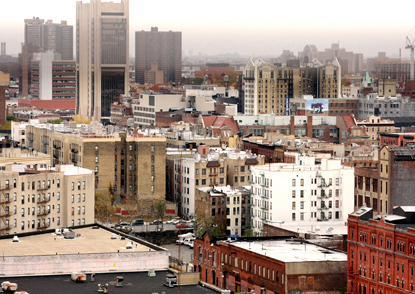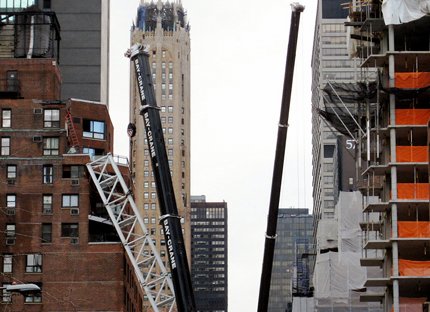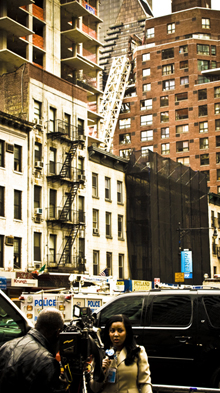Fiber Optics: Bringing the Next Big Thing to New York

On April 15, after months of negotiations, Verizon announced it would file an application with the city's Department of Information Technology and Telecommunications to offer video service throughout the city. If that application is approved, it will be the company's cue to ramp up its installation of fiber optic cables to every home in New York and start offering its FiOS package of Internet, video, voice and even wireless for those customers who really love a one-stop-shop. Verizon says it could begin offering the video service by the end of the year.
I'm not trying to hype the service - Verizon's television advertising campaign can take care of that. But the widespread adoption of DSL and cable changed the Internet radically, making photo galleries and short videos commonplace; the next generation of connection speeds will likely yield a similar transformation. An uncompressed feature film will download in a half an hour over a fiber optic connection compared to almost 10 hours on DSL and practically never on dial-up.
Replacing the paired copper wires that make up the telephone network with new fiber optic wires is an expensive proposition. Verizon won't discuss the specific dollar figures involved for New York, but in the 16 states where it is rolling out FiOS, Verizon plans to spend nearly $23 billion between 2004 and 2010. The New York installation alone would run into the billions and extend past that timeline. An investment of this magnitude will be the most significant thing to happen to New York's telecommunications infrastructure since the initial installation of cable television.
"This is a market-changing deal," said Councilmember Gale Brewer, referring both to its financial size and to the impact of running fiber optic cables to every residence in the city.
Closing the Deal
As Juan Gonzalez reported in the Daily News last fall, the Bloomberg administration and Verizon have been conducting secret negotiations for months. Although the application must still clear a number of hurdles, Verizon's announcement seems to indicate that it and the city have made some progress in the talks.
Based on the statements by members of the City Council and the public interest community, there have been a number of key issues.
The first is buildout. If you live in the outer boroughs or a poor neighborhood, you want Verizon to offer service to the entire city as quickly as possible, say five years, rather than offering service just to wealthy neighborhoods. In its statement, Verizon said it would build the fiber optic network througout the entire city by 2014. The smattering of buildings that already have FiOS service are dispersed throughout all the boroughs, determined by their proximity to a Verizon connection point and the willingness of the building owner, according to Verizon. The company points to this as evidence that it would not discriminate against poor neighborhoods even over a longer timeline.
New York's architecture had posed a particular challenge. Fiber optic wires are made of glass or plastic and transmit light, so it was difficult to run them through the tight corners of old apartment buildings. But last year, Corning, the upstate New York glass company, invented a bendable fiber. Verizon is already using Corning's technology to bring fiber optic service to the 11,232 apartments in Stuyvesant Town and Peter Cooper Village.
Another issue centered arund whether Verizon would commit to funding centers like Manhattan Neighborhood Network and Brooklyn Community Access Television where people can go to use expensive television production equipment and broadcast their programming. Existing cable providers already do this. But the Internet is different. People can upload video content from their homes. Training and equipment access can happen at the neighborhood level. Verizon representatives visited the public access centers recently, andthe company probably is willing to match the incumbents' support in that realm, but might balk at going further. Is statement did not address this.
"Public access and citywide buildout are a given," Brewer said, "but Verizon also needs to support the social layer." That means all of the things in addition to access that people need to use the Internet, especially computers, training and relevant content. There are many groups in the city like Per Scholas in the Bronx and Computers For Youth that provide these kinds of services. Since the Bush administration cut community technology funding in his first term, these programs have relied almost exclusively on foundation support.
Faster than Your Average Internet
With the FiOS installation, residents of Stuyvesant Town and Peter Cooper Village are able to purchase Internet service at up to 50 mbps. (Mbps is million bits per second and is the standard measure of bandwidth.) That's 20 times faster than what most of us can get from cable or DSL and 750 times faster than a dial-up connection of 56 thousand bits per second.
These speed differentials represent a new kind of digital divide. The gulf between the online experiences of a person connecting at 20 mbps over a fiber optic connection and a person connecting at a fraction of that over copper wires is as dramatic as between the latter and someone who has no in-home connection at all. It's like going from standing to walking to driving.
The fiber optic service is also symmetrical, meaning the same speed for upload and download connection. Most Internet service is asymmetrical, meaning you can download (receive) faster than you can upload (send).
"I really think it does give people access to a whole other Internet," Ellen Yu, a spokesperson for Verizon, said.
But Not Fast Enough
While New York inches towards connections of 20 to 50 mbps, foreign cities like Hong Kong and Amsterdam are moving to 100 mbps. The challenge for New York City, then, is threefold. At the same time it works to cross the traditional online/offline divide, it needs to both close the gap between those with marginal access and those with speedy and convenient access and catch up to other world-class cities.
Some cities, like Seattle and San Francisco, have considered municipally backed fiber networks to solve this problem and bring internationally competitive Internet service speeds to their residents, but the cost and timeframe can be daunting. Entrepreneur Brewster Kahle recently paid to wire a San Francisco public housing complex directly into the local backbone, giving residents access at up to 1 gigabit, or 1000 mbps. Smaller cities like Burlington, Vermont, have built such networks and are providing the "triple play" of services - voice, video, and Internet - themselves and at lower prices than the incumbent cable company. From the looks of it, New York public officials are going to rely on the private sector, especially Verizon, to bring us the next generation of broadband.
Regulating Fiber Optics
Currently, the fiber optic service in Stuy Town and other select buildings around town carries just phone and Internet. It has the potential to provide video as well but is not currently doing so.
This is more a political issue than a technical one. The government regulates Internet service, phone service and television service differently - even though they can travel over the same wires. So Verizon can replace its copper wires with fiber optic lines and start selling Internet access over those lines, but it cannot sell TV service until it gets a franchise from the city.
The government also regulates the different wires differently, so Verizon is required to lease its copper wires to competitors, but that requirement does not apply to the new fiber optic lines. In some cases, the company has removed the old copper wires when they install FiOS, meaning you - or subsequent residents - can't go back to the cheaper DSL service once you upgrade. In general, though, Yu says Verizon's current practice in New York is to leave the copper in place unless the customer requests removal. Either way, the potential revenue from the video service is the primary motivation for Verizon to install FiOS throughout the entire city.
The entry of Verizon into the market would dramatically change the television system in New York. Currently, even though there are multiple cable operators in the city, a household only has one choice for cable TV because each franchise covers a specific area. Where customers have a choice of cable operators, subscribers usually see price reductions of 15 percent, according to Chuck Bell of Consumers Union.
If Verizon got a franchise to sell television service over its fiber optic network, that would provide New Yorkers with another choice -- along with cable and satellite -- for TV. The cable companies would probably cut rates to compete, though perhaps only in the neighborhoods where FiOS is available.
Meanwhile, these cable provider's ostensible monopolies have led to growing customer dissatisfaction. Time Warner and Cablevision are currently negotiating renewals of their 10-year franchises, so Consumers Union and New York Public Interest Research Group worked with Comptroller Bill Thompson to draft a "Cable Consumers Bill of Rights," which they announced on March 26. Among other things, it would seek to make the companies more accountable on service issues, provide more information about customer bills and charges, protect customers' privacy and give New Yorkers greater access to independently owned channels.
The comptroller is a member of the Franchise Concession and Review Committee, which also includes mayoral appointees and relevant borough presidents. The franchise committee would have to approve any deal involving television services reached between Verizon and the Department of Information Technology and Telecommunications. The deal would then need an OK from the state Public Service Commission.
Consumers Union's Bell urges vigilance: "So many issues are on the table during negotiations, there's always a chance that things will get dropped. We also have to think carefully how this changes over the life of the franchise. Technologies change. People's needs change." Most people didn't even have dial-up when the current franchises were first inked.
If you want to voice your opinion on the Verizon deal, the franchise committee is required to hold a public hearing on the franchise for television services, so stay tuned for that announcement.
Â
Advocates Find Hope in Albany, Fear in D.C.

Despite all the turmoil in Albany in the past few weeks, housing advocates remain optimistic about their chances for success in the state capital. The news from Washington was far grimmer. There, a sudden and massive cut in funds for the federal Section 8 rent subsidy program could drastically affect the city's housing situation.
Appraising David Paterson
At a town hall meeting in Harlem to discuss housing issues, the topics on the agenda included the loss of Mitchell-Lama apartments to market rate housing and the expansion of Columbia University into Manhattanville, hot topics that have led many to despair. But the mood was buoyed by the realization that a Harlemite had become New York's governor.
"We can be cautiously optimistic," Nellie Bailey of the Harlem Tenants Council told the audience. "Governor Paterson will be better than Elliott Spitzer on our issues."
It's a refrain that many housing advocates have been repeating as the shock of former Gov. Eliot Spitzer's political demise subsides.
"Certainly from our point of view [Paterson] will be much, much better," said Michael McKee of Tenants PAC. "He's fundamentally pro-tenant whereas Spitzer wasn't. Spitzer was certainly better than (former Gov. George) Pataki, but I'm not sure how much Spitzer really believes in regulation of housing, for example."
Paterson has a commitment to tenant issues, McKee added, a comment other advocates echoed.
"Governor Paterson will be very good for tenants," said Jenny Laurie of the Metropolitan Council on Housing. "He's always supported tenant issues and he's very knowledgeable. And he's got all of the different types of housing in his district -- rent regulated apartments, Section 8 and Mitchell-Lama projects and New York City Housing Authority buildings."
On at least one major issue, the expansion of Columbia University into West Harlem, Paterson's views are encouraging to housing advocates, most of whom oppose the plan in its current form. In 2005, Paterson called on then-Governor Pataki to issues a six-month moratorium on the use of eminent domain to take private property for the university's use. But as the leader of the minority in the State Senate, Paterson did not have the power to get much done.
Just a month ago, Paterson headlined a fundraiser for McKee's group at a bowling alley in Harlem. "David's a friend," McKee said, adding, "I know from talking to him over the years that he is pro-tenant and pro-rent regulation.... I think he understands what ordinary people go through just to make a go of it."
Another advocate who asked to remain anonymous lest a comment affect political relationships said Paterson could prove a disappointment.
"In the past, he's been an over-committer," the advocate said.
The ascension of Paterson to the top spot in state government does not change the fact that the State Senate, if it remains under Republican Joe Bruno's leadership, still has the power to block progressive policy on housing issues, McKee said. So, Election Day remains the key date for housing advocates, he said.
"Everything is dependent on the senate changing in November," he said. "If Bruno holds on by one vote, we won't be able to change anything."
Bad News for Section 8
November also could be key to what happens in Washington. The Bush administration cut $2.4 billion from the federal Section 8 rent subsidy program in March, which effectively threatens 90,000 households in the city that rely on the subsidy to help pay their rents. The cut means that the Section 8 program can only meet its commitment to landlords through September 2008 -- as many as 500,000 Section 8 vouchers nationally would have to be cut to make up the shortfall.
The problem of funding has existed at least since last year when some Section 8 landlords did not receive payments owed them. At its root is a change in how the vouchers are funded. Contracts for low-income housing used to last for 20 to 30 years. In the 1990s, though, the Department of Housing and Urban Development began to switch to shorter term -- one to five year -- agreements. With funding tight and Congress cutting back, the department dipped into funds to cover shortfalls, leaving it without money to pay its obligations toward the end of the year, John Cox, the department's chief financial officer http://www.hud.gov/offices/cir/test071017.cfm told Congress last year.
This leaves landlords caught in the middle. When developers accepted tax breaks and other incentives to build affordable housing decades ago, they did so with the understanding that after 20 or 40 years they could opt out of the program. "It's another incentive to get out" of the Section 8 program," and so could s speed the loss of affordable Section 8 project apartments, said Patrick Coleman of Tenants & Neighbors. "Almost 10,000 families are living in buildings and now in danger of their owners saying 'forget it.'"
HUD thinks the problem can be solved, said spokesman Brian Sullivan. He conceded there had been a basis for concern. "There are people who are understandably nervous because you have landlords who, if they don't get paid, they don't want to play. In certain extreme situations, there were some suggestions that landlords would evict tenants because they weren't getting paid," Sullivan said. He added that he did not think anyone had been evicted because of the funding situation. Sullivan said the department believes the situation has been remedied. "We are confident that we have sufficient funding to meet our obligations in FY 2008 and we are seeking sufficient funding in 2009," he said.
Not everyone is so sure, though. On a rainy March night in Greenwich Village, about 150 people filled a church as three members of Congress from the city -- Yvette Clarke, Jerry Nadler and Nydia Velasquez -- decried the cuts. They signed a pledge to work to restore the funding.
Sullivan questioned the rally. "We believe [the funding shortfall problem] has been corrected and we don't think scare tactics are necessary (referring to the rally," he said.
Joe Lamport is the assistant director of the City-Wide Task Force on Housing Court, a coalition of community housing organizations. Â
Cleaning Up an Agency and an Accident

In my East Side and midtown Manhattan district you will find giant cranes and new high-rise buildings on nearly a third of the densely populated blocks -- the same blocks that experienced the tragic crane accident last week that claimed seven lives and left scores injured and displaced from their homes. Since then, all of the questions from people in my community have been about how an accident of this nature could happen; what we need to do to protect workers and residents; and why the frequency of these incidents seem to be escalating. Of course, we have now learned that whatever technically caused the crane to topple, we cannot rely on the Department of Building's system of inspection. At least one of their inspectors admitted he didn't show up for the inspection.
The Problem
Our city's approach to construction approvals and safety has been fundamentally flawed since changes were enacted by the Giuliani administration. Because of a lack of enforcement by the Department of Buildings, along with an extremely hot real estate market, many developers and their contractors ignore safety requirements, disregard building codes and violate zoning laws.
For too many years, the city has under staffed agencies charged with oversight, has had an ineffective penalty and deterrence model, and has allowed the development and construction industry to police itself.
People complain that government is too often reactive, not proactive, and that only after crises are real solutions proposed. Fair enough. I say there have been too many of these types of accidents, and I don't accept the "freak accident" excuse.
Either our inspection and safety protocols are wrong or the people charged with carrying them out have failed at their jobs (as was clearly the case here!) -- or both. There must be changes from the top down, starting with the resignation of the Department of Buildings Commissioner Patricia Lancaster. The department does not have a centralized database for tracking or correlating information between stop work orders, violations and enforcement outcomes.
A 2003 city comptroller's audit found that 67 percent of sampled construction plans that were submitted to the department through self-certification had errors. By 2007, nearly 50 percent were in error. New York City's Department of Buildings initiated self-certification in 1995 to help ease a permit backlog. The practice allows architects and engineers to confirm that their plans comply applicable laws, rather than submit plans to department inspectors. It accounted for nearly half the 6,000 new building permits issued in 2006 and a similar number in 2007.
Some State Solutions
Since the city has been resistant to mandating stricter safety standards, and the department isn't moving forward on its own, there is a role for the state to play. Here are just some of the bills currently in the Senate and/or Assembly:
New legislation can provide more tools to our agencies. However, if laws are not enforced, they are not worth the paper we wrote them on. The city needs to enforce the laws that are on the books and provide the department with the resources it needs to conduct full inspections, prioritizing them by size of project and the risks involved.

Raising the City's Standards
Reports indicate that the cause of the crane collapse may be a damaged or frayed strap used to stabilize it, which could not bear the load. While building department records showed that the site, including the crane, had been inspected by the department shortly before the accident, we have since learned that at least some of those inspections did not take place.
This chain of events perfectly exemplifies the need for better enforcement and oversight by the Department of Buildings. City officials were called in to inspect complaints on the site. At least one inspector failed to show up, but submitted reports that indicated everything was fine. Assuming others did show up as required, did they know what to look for? Did they see the problems? Did they crosscheck resolution of the 14 outstanding safety violations at the site while they were there that day? As Robert Guskind of the website Gowanus Lounge says, even if the department "functioned like a well-oiled machine that rigorously enforced city regulations, its inspectors are still overwhelmed by the level of construction." I agree.
In many instances, the city's response to violations has been something like: "It's already done so there is nothing we can do." In the case of most violations issued, the developer goes before the Environmental Control Board. However, the board often won't hear complaints for months and the developer can easily get hearings postponed. When cases are finally heard, the fines are usually so small that they are considered "the cost of doing business."When scofflaws laugh about petty cash penalties, we know we have a problem. Fines need to be enforced in a timely way, and dramatically increased to adequately serve as a deterrent.
The Department's Role
In December, the Daily News reported that an architect of 32 sites received "an unusual stipulation, promising not to report the Ă«alleged misdeeds to any regulatory agency,' including one that could revoke his license," by the department commissioner. She should have stepped down from her position then. If the city is serious about addressing these concerns, step one would be for her to step down now.
In another instance, a Brooklyn developer was found to have 48 violations from one development -- the same development he certified at 100 percent compliance. The developer of the site of the crane accident had 14 violations. Though none were deemed extremely serious, there should be a clearly defined timeline during which developers must bring their sites up to code or be forced to stop their work. This must occur within hours, or at most days, not months or years.
New York should not accept a model of construction safety that relies on a neighbor seeing something wrong and reporting it. Though residents are encouraged to report problems, the role of the department should be to prevent problems beforehand. It must be on the scene even before complaints are reported, and when complaints do come in, it needs to take them seriously and address them fully. Despite the department's mission to "ensure the safe and lawful use of over 950,000 buildings and properties by enforcing the City's Building Code, Electrical Code, Zoning Resolution, New York State Labor Law and New York State Multiple Dwelling Law," the agency does not seem to fully understand its role in actually ensuring "safe and lawful" sites. And increased funding is not the silver bullet.
If the city is unable to provide more money for staffing, then the cost of permits must be raised accordingly to fund new inspectors and a faster penalty system. A study conducted by then-Assembly member (now borough president) Scott Stringer in 2002 revealed that the city could generate more than $10 million a year to hire additional inspectors by actually collecting the fines the Environmental Control Board issues each year.
The lack of enforcement, oversight and accountability within the Department of Buildings allows those developers and construction firms, who put profit before the safety of the public and their workers, to shirk city and state laws and codes.
Liz Krueger, a Democrat, is a state senator from Manhattan's East Side.Â




